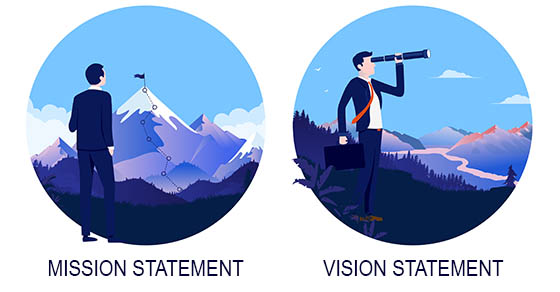
Many of today’s businesses operate in a cacophonous marketplace. Everyone is out blasting emails, pushing notifications and proclaiming their presence on social media. Where does it all leave your customers and prospects? Quite possibly searching for a clear perception of your company.
One way — well, two ways — to rise above the din is to craft a mission statement and a vision statement. Although they may seem like superfluous marketing exercises to some, these two statements can help clarify your identity to customers and prospects. They can also matter to lenders, investors, the news media and job candidates.
Why you’re here
Let’s start with the mission statement. Its purpose is to express to the world why you’re in business, what you’re offering and whom you’re looking to serve. For example, the U.S. Department of Labor has this as its mission statement:
To foster, promote, and develop the welfare of the wage earners, job seekers, and retirees of the United States; improve working conditions; advance opportunities for profitable employment; and assure work-related benefits and rights.
Forget flowery language and industry jargon. Write in clear, simple, honest terms. Keep the statement brief, a paragraph at most. Answer questions that any interested party would likely ask. Why did your company go into business? What makes your products or services worth buying? Who’s your target market?
You know the answers to these questions. But distilling them into a clear, concise mission statement can do more than raise your visibility in the marketplace. It may also help renew your commitment to your original or actual mission or reveal where you’ve gotten off track.
With a mission statement in place, you can engage in more focused strategic planning. Moreover, it helps boost employee engagement, serving as a driving philosophy for everyone. And as mentioned, the right mission statement really is a marketing asset: It tells the buying public precisely who you are.
Where you’re going
So, what does a vision statement do? It tells interested parties where you’re going; that is, what you want to accomplish.
A vision statement should be even briefer than your mission statement. Think of it as a tagline for a movie or even an advertising slogan. You want to deliver a memorable quote that will get readers’ attention and let them know you’re moving into a future where you’ll provide the highest quality products and services in your industry.
Whereas a mission statement is anchored in the present, a vision statement focuses on the horizon. For instance, the mission statement of the Alzheimer’s Association is:
The Alzheimer’s Association leads the way to end Alzheimer’s and all other dementia — by accelerating global research, driving risk reduction and early detection, and maximizing quality care and support.
But its vision statement is simply: “A world without Alzheimer’s and all other dementia.”
Create a vision statement that’s a rallying cry for your company. Don’t be afraid to be aspirational, bold and appeal to people’s emotions. Remember, this isn’t where you are, it’s where you intend to go.
How to proceed
Creating mission and vision statements can be a fun, creative way to unite a company. If you already have both, well done! But don’t forget that you can still revisit and refine the language. And if you ever decide to do a major marketplace pivot or even undergo a business transformation, you’ll likely want to rewrite your mission and vision statements entirely.
© 2025




